Energy harvesting - Based transmission schemes in cognitive radio networks with a power beacon
Energy harvesting is emerged as a promising technique to solve the energy constraint problem of wireless
communications networks. In this paper, new energy harvesting-based transmission schemes are proposed
to improve the outage probability and throughput in underlay cognitive radio networks. In this system, a
secondary source can harvest energy from a power beacon (PB) and/or a primary transmitter (PT) to
transmit data to a secondary destination in the presence of a primary receiver. Particularly, we propose the
BS, TS and SBT schemes to improve system performance. The BS scheme tries to harvest energy from the
PB while the TS scheme harvests energy only from The PT. In the SBT scheme, the energy harvested from
both PB and PT is used for data transmission. For performance evaluation, we derive the exact closed-form
expressions for the outage probability and throughput of the proposed schemes over Rayleigh fading
channels, which are latter verified by Monte Carlo simulations.
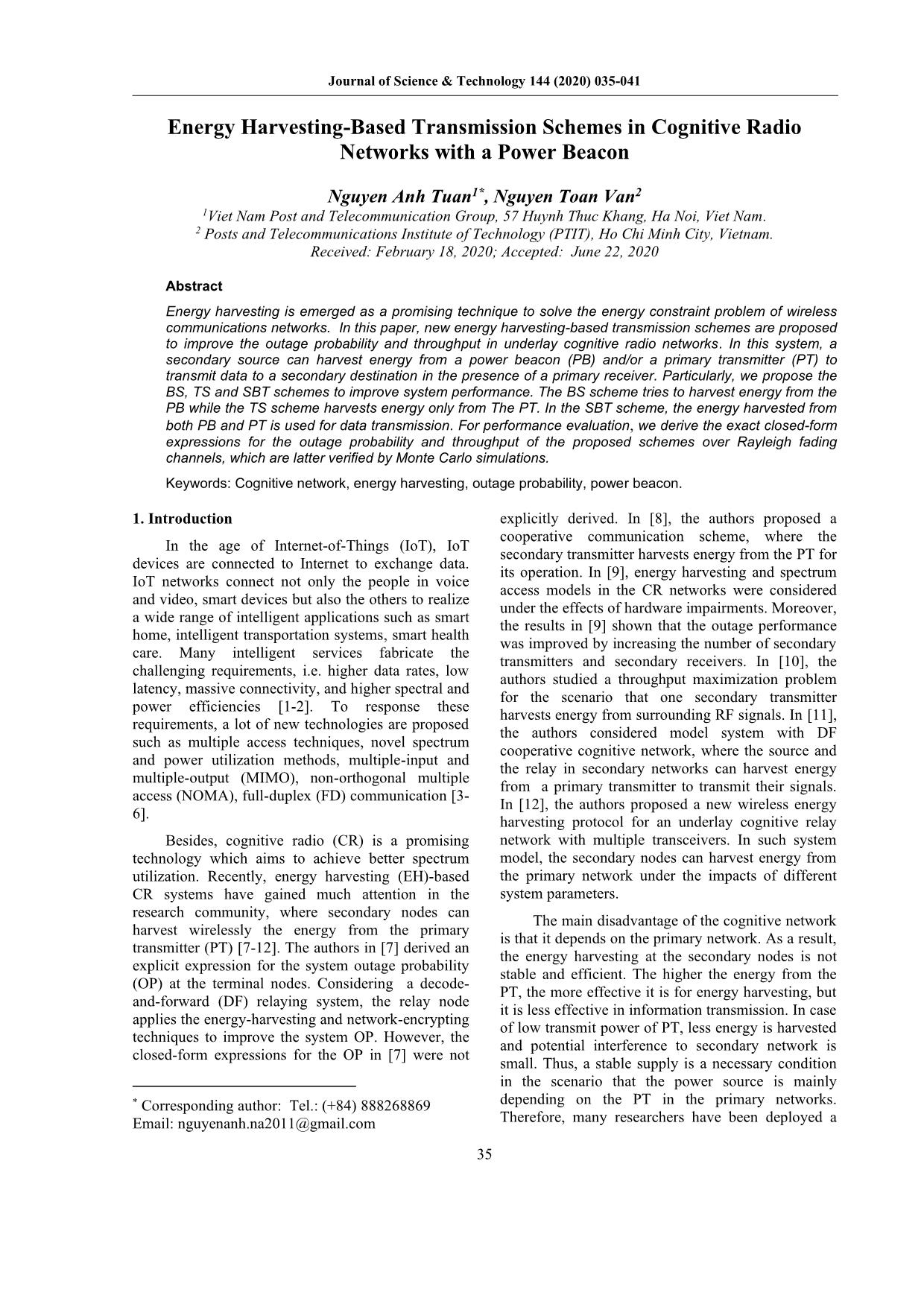
Trang 1
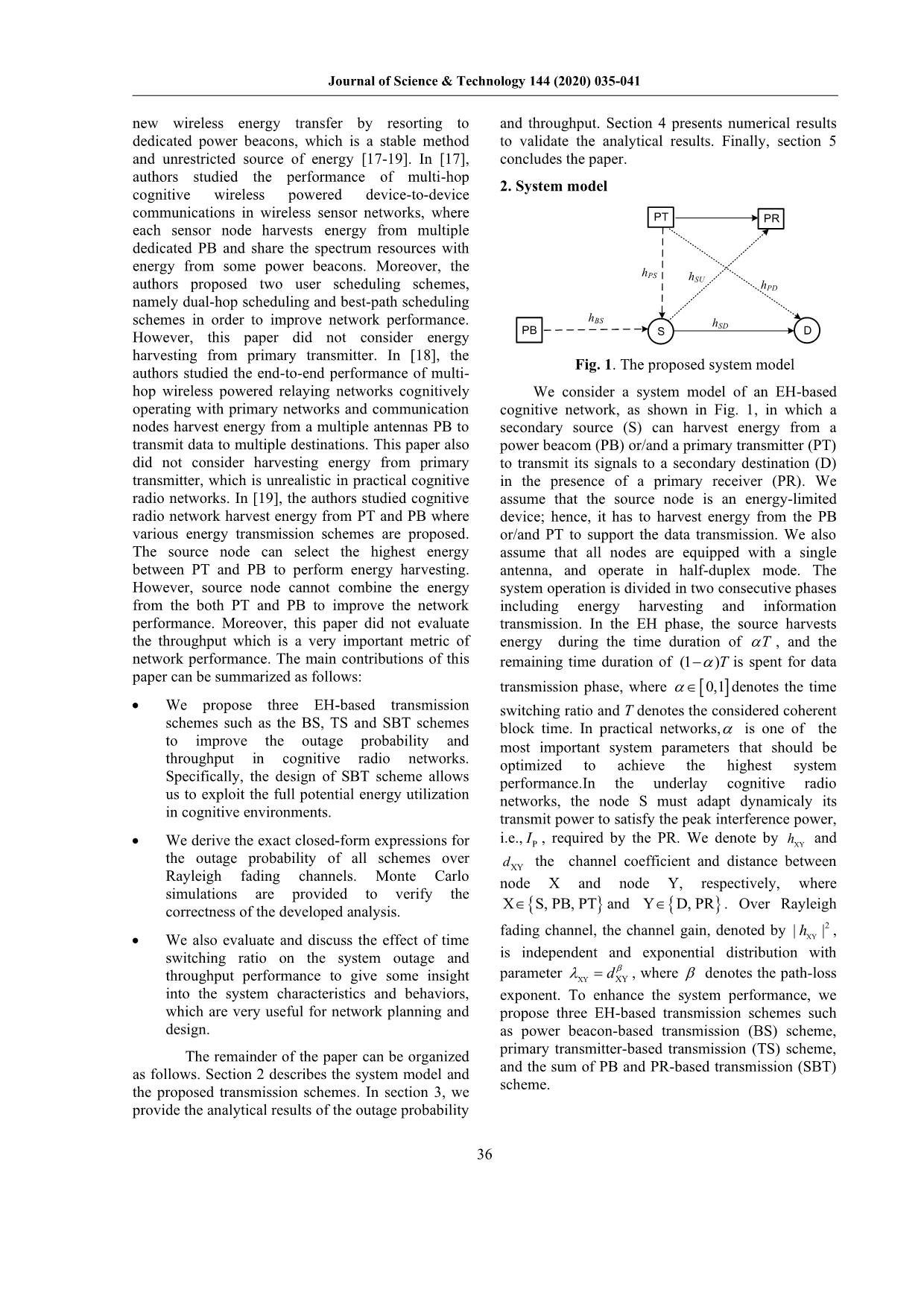
Trang 2
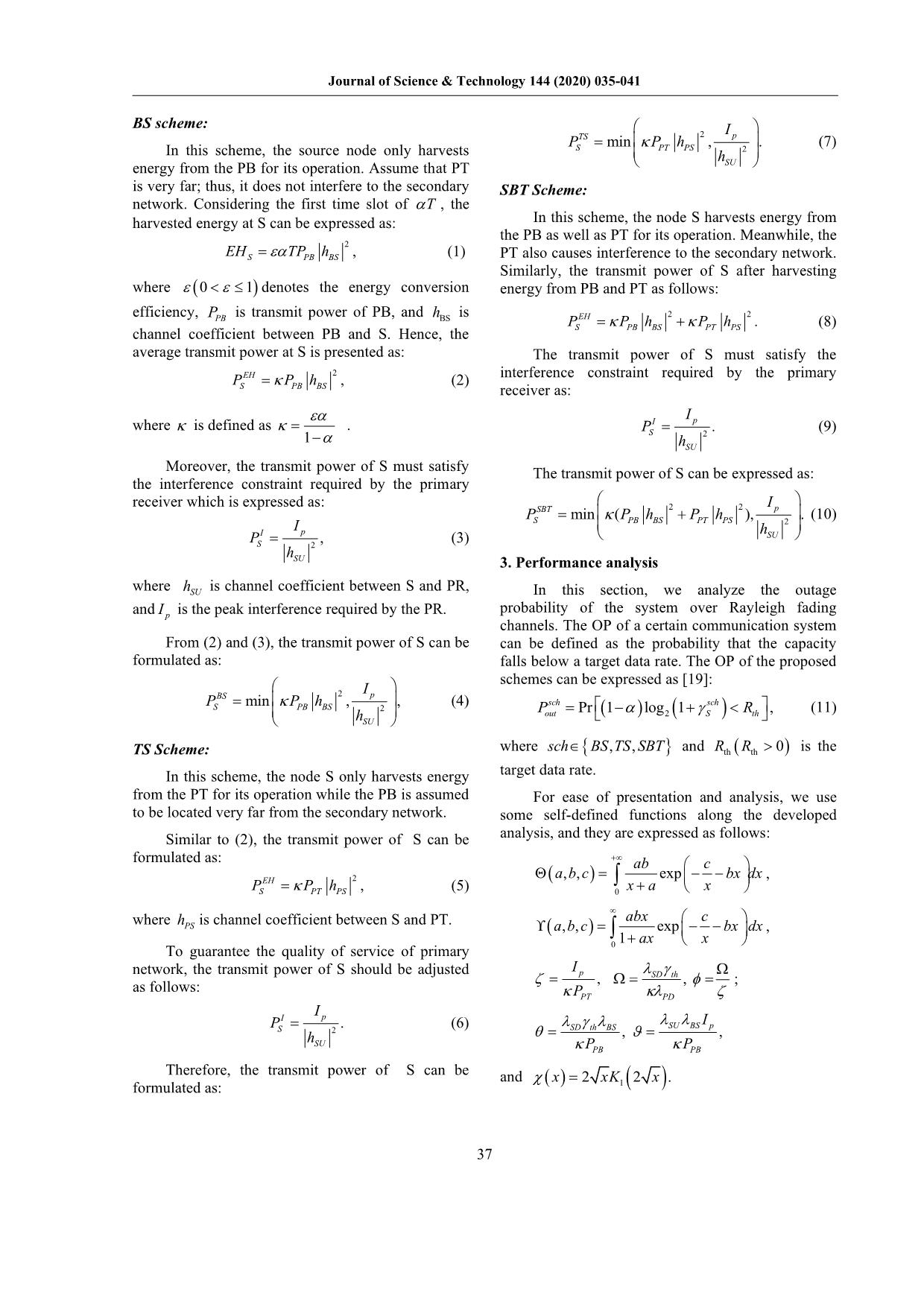
Trang 3
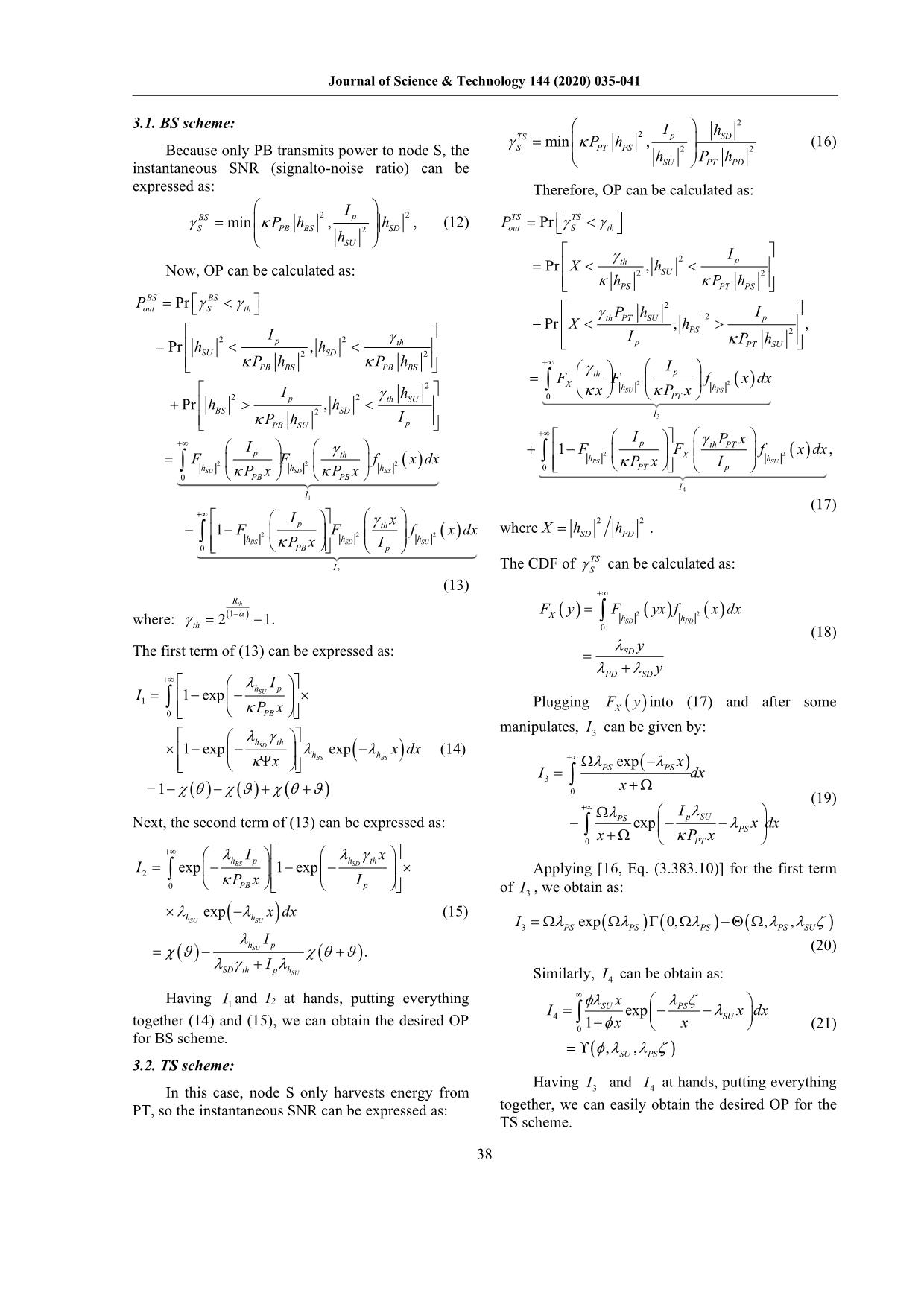
Trang 4
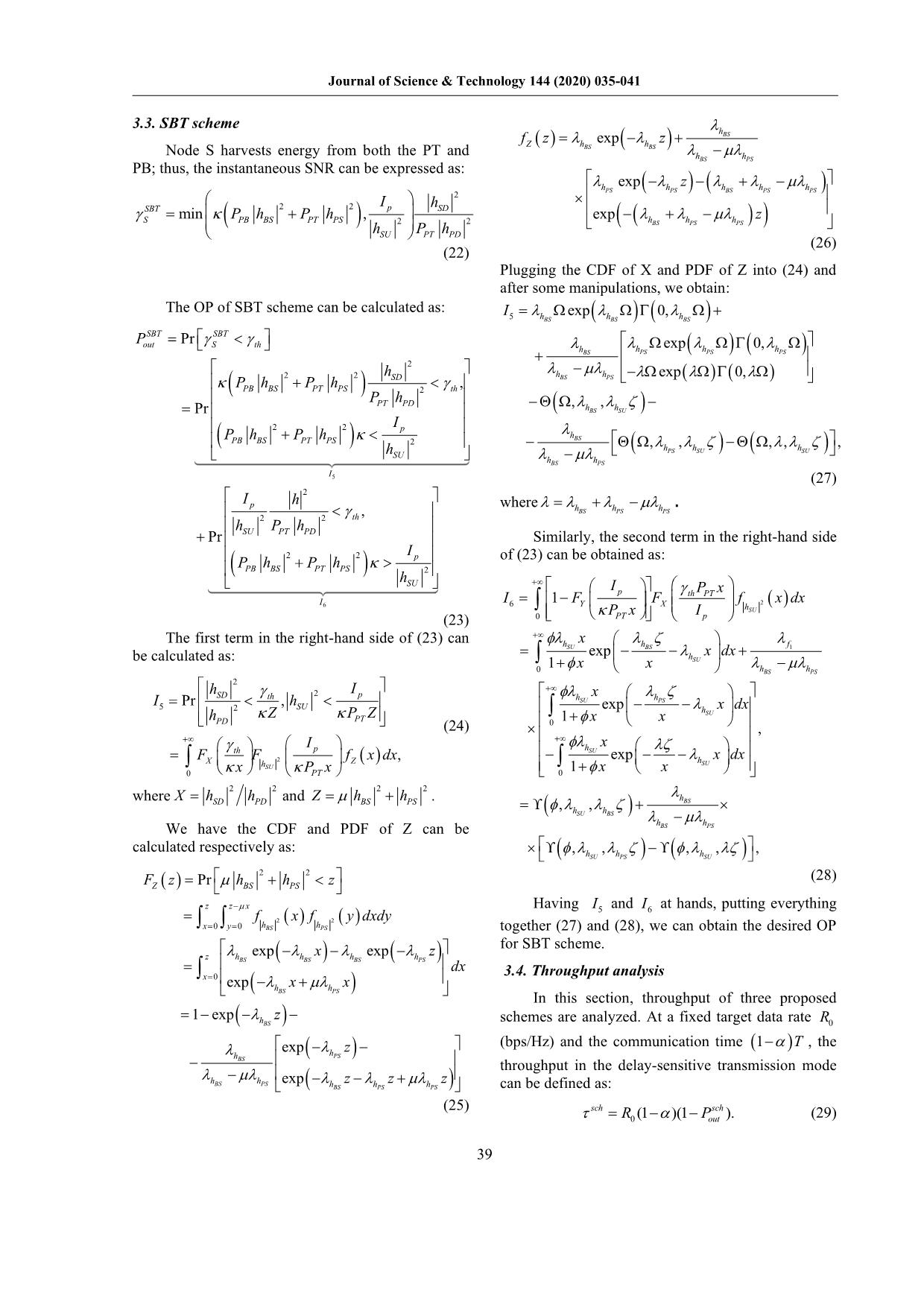
Trang 5
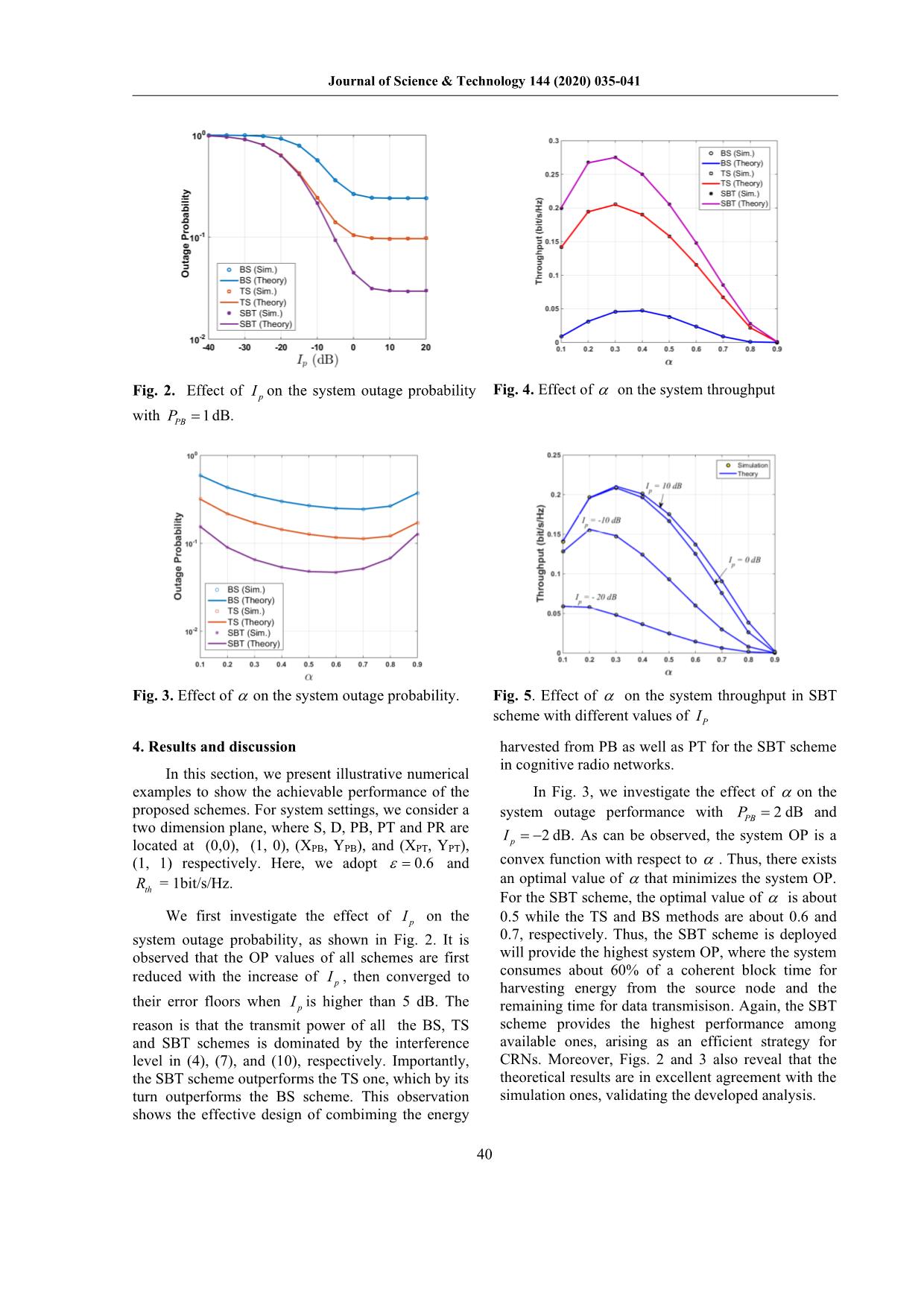
Trang 6
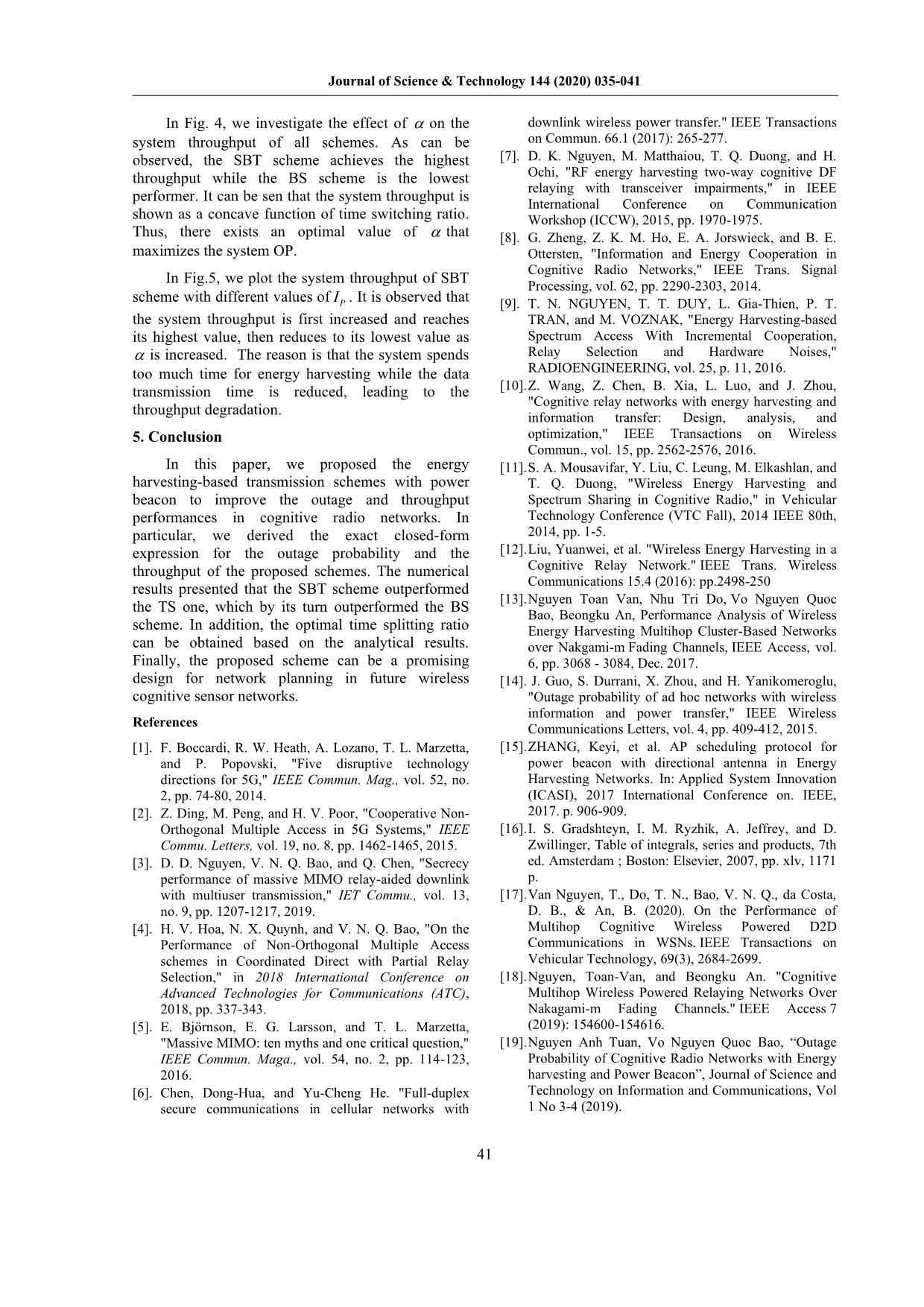
Trang 7

Trang 8
Tóm tắt nội dung tài liệu: Energy harvesting - Based transmission schemes in cognitive radio networks with a power beacon
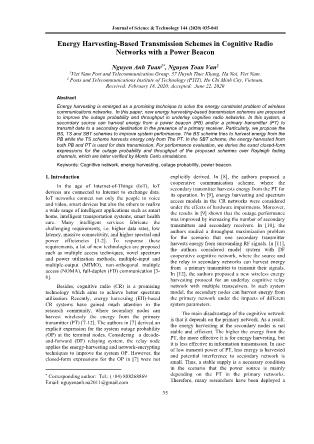
r of S can be formulated as: 2 2 min , . pTS S PT PS SU I P P h h = (7) SBT Scheme: In this scheme, the node S harvests energy from the PB as well as PT for its operation. Meanwhile, the PT also causes interference to the secondary network. Similarly, the transmit power of S after harvesting energy from PB and PT as follows: 2 2 .EHS PB BS PT PSP P h P h = + (8) The transmit power of S must satisfy the interference constraint required by the primary receiver as: 2 . pI S SU I P h = (9) The transmit power of S can be expressed as: 2 2 2 min ( ), . pSBT S PB BS PT PS SU I P P h P h h = + (10) 3. Performance analysis In this section, we analyze the outage probability of the system over Rayleigh fading channels. The OP of a certain communication system can be defined as the probability that the capacity falls below a target data rate. The OP of the proposed schemes can be expressed as [19]: ( ) ( )2Pr 1 log 1 ,sch schout S thP R = − + (11) where , ,sch BS TS SBT and ( )th th 0R R is the target data rate. For ease of presentation and analysis, we use some self-defined functions along the developed analysis, and they are expressed as follows: ( ) 0 , , exp ab c a b c bx dx x a x + = − − + , ( ) 0 , , exp 1 abx c a b c bx dx ax x = − − + , , p PT I P = ,SD th PD = = ; , , SU BS pSD th BS PB PB I P P = = and ( ) ( )12 2 .x xK x = Journal of Science & Technology 144 (2020) 035-041 38 3.1. BS scheme: Because only PB transmits power to node S, the instantaneous SNR (signalto-noise ratio) can be expressed as: 2 2 2 min , , pBS S PB BS SD SU I P h h h = (12) Now, OP can be calculated as: ( )2 2 2 1 2 2 2 2 2 2 2 2 2 0 Pr Pr , Pr , 1 SU SD BS BS BS BS out S th p th SU SD PB BS PB BS p th SU BS SD pPB SU p th h h h PB PB I p h PB P I h h P h P h I h h h IP h I F F f x dx P x P x I F P x + = = + = + − ( )2 2 2 0 SD SU th h h p I x F f x dx I + (13) where: ( )1 2 1. thR th − = − The first term of (13) can be expressed as: ( ) ( ) ( ) ( ) 1 0 1 exp 1 exp exp 1 SU SD BS BS h p PB h th h h I I P x x dx x + = − − − − − = − − + + (14) Next, the second term of (13) can be expressed as: ( ) ( ) ( ) 2 0 exp 1 exp exp . BS SD SU SU SU SU h p h th PB p h h h p SD th p h I x I P x I x dx I I + = − − − − = − + + (15) Having 1I and I2 at hands, putting everything together (14) and (15), we can obtain the desired OP for BS scheme. 3.2. TS scheme: In this case, node S only harvests energy from PT, so the instantaneous SNR can be expressed as: 2 2 2 2 min , p SDTS S PT PS SU PT PD I h P h h P h = (16) Therefore, OP can be calculated as: ( )2 2 3 2 2 2 2 2 2 2 0 0 Pr Pr , Pr , , 1 SU PS PS TS TS out S th pth SU PS PT PS pth PT SU PS p PT SU pth X h h PT I p t Xh PT P I X h h P h IP h X h I P h I F F f x dx x P x I F F P x + + = = + = + − ( )2 4 , SU h PT h p I P x f x dx I (17) where 2 2 SD PDX h h= . The CDF of TS S can be calculated as: ( ) ( ) ( )2 2 0 PDSD X hh SD PD SD F y F yx f x dx y y + = = + (18) Plugging ( )XF y into (17) and after some manipulates, 3I can be given by: ( ) 3 0 0 exp exp PS PS p SUPS PS PT x I dx x I x dx x P x + + − = + − − − + (19) Applying [16, Eq. (3.383.10)] for the first term of 3I , we obtain as: ( ) ( ) ( )3 exp 0, , ,PS PS PS PS SUI = − (20) Similarly, 4I can be obtain as: ( ) 4 0 exp 1 , , SU PS SU SU PS x I x dx x x = − − + = (21) Having 3I and 4I at hands, putting everything together, we can easily obtain the desired OP for the TS scheme. Journal of Science & Technology 144 (2020) 035-041 39 3.3. SBT scheme Node S harvests energy from both the PT and PB; thus, the instantaneous SNR can be expressed as: ( ) 2 2 2 2 2 min , p SDSBT S PB BS PT PS SU PT PD I h P h P h h P h = + (22) The OP of SBT scheme can be calculated as: ( ) ( ) ( ) 5 6 2 2 2 2 2 2 2 2 2 2 2 2 2 Pr , Pr , Pr SBT SBT out S th SD PB BS PT PS th PT PD p PB BS PT PS SU I p th SU PT PD p PB BS PT PS SU I P h P h P h P h I P h P h h I h h P h I P h P h h = + = + + + (23) The first term in the right-hand side of (23) can be calculated as: ( )2 2 2 5 2 0 Pr , , SU pSD th SU PTPD pth X Zh PT Ih I h Z P Zh I F F f x dx x P x + = = (24) where 2 2 SD PDX h h= and 2 2 BS PSZ h h= + . We have the CDF and PDF of Z can be calculated respectively as: ( ) ( ) ( ) ( ) ( ) ( ) ( ) ( ) ( ) 2 2 2 2 0 0 0 Pr exp exp exp 1 exp exp exp BS PS BS BS BS PS BS PS BS PS BS BS PS BS PS PS Z BS PS z z x h hx y z h h h h x h h h hh h h h h h F z h h z f x f y dxdy x z dx x x z z z z z − = = = = + = − − − = − + = − − − − − − − − − + (25) ( ) ( ) ( ) ( ) ( )( ) exp exp exp BS BS BS BS PS PS PS BS PS PS BS PS PS h Z h h h h h h h h h h h h f z z z z = − + − − − + − − + − (26) Plugging the CDF of X and PDF of Z into (24) and after some manipulations, we obtain: ( ) ( ) ( ) ( ) ( ) ( ) ( ) ( ) ( ) 5 exp 0, exp 0, exp 0, , , , , , , , BS BS BS PS PS PSBS BS PS BS SU BS PS SU SU BS PS h h h h h hh h h h h h h h h h h I = + + − − − − − − − (27) where BS PS PSh h h = + − . Similarly, the second term in the right-hand side of (23) can be obtained as: ( )2 1 6 0 0 0 0 1 exp 1 exp 1 exp 1 SU SU BS SU BS PS SU PS SU SU SU p th PT Y X h PT p h h f h h h h h h h h I P x I F F f x dx P x I x x dx x x x x dx x x x x dx x x + + + + = − = − − + + − − − + − − − + ( ) ( ) ( ) , , , , , , , , BS SU BS BS PS SU PS SU h h h h h h h h = + − − (28) Having 5I and 6I at hands, putting everything together (27) and (28), we can obtain the desired OP for SBT scheme. 3.4. Throughput analysis In this section, throughput of three proposed schemes are analyzed. At a fixed target data rate 0R (bps/Hz) and the communication time ( )1 T − , the throughput in the delay-sensitive transmission mode can be defined as: 0 (1 )(1 ). sch sch outR P = − − (29) Journal of Science & Technology 144 (2020) 035-041 40 Fig. 2. Effect of pI on the system outage probability with 1PBP = dB. Fig. 4. Effect of on the system throughput Fig. 3. Effect of on the system outage probability. Fig. 5. Effect of on the system throughput in SBT scheme with different values of PI 4. Results and discussion In this section, we present illustrative numerical examples to show the achievable performance of the proposed schemes. For system settings, we consider a two dimension plane, where S, D, PB, PT and PR are located at (0,0), (1, 0), (XPB, YPB), and (XPT, YPT), (1, 1) respectively. Here, we adopt 0.6 = and thR = 1bit/s/Hz. We first investigate the effect of pI on the system outage probability, as shown in Fig. 2. It is observed that the OP values of all schemes are first reduced with the increase of pI , then converged to their error floors when pI is higher than 5 dB. The reason is that the transmit power of all the BS, TS and SBT schemes is dominated by the interference level in (4), (7), and (10), respectively. Importantly, the SBT scheme outperforms the TS one, which by its turn outperforms the BS scheme. This observation shows the effective design of combiming the energy harvested from PB as well as PT for the SBT scheme in cognitive radio networks. In Fig. 3, we investigate the effect of on the system outage performance with 2PBP = dB and 2pI = − dB. As can be observed, the system OP is a convex function with respect to . Thus, there exists an optimal value of that minimizes the system OP. For the SBT scheme, the optimal value of is about 0.5 while the TS and BS methods are about 0.6 and 0.7, respectively. Thus, the SBT scheme is deployed will provide the highest system OP, where the system consumes about 60% of a coherent block time for harvesting energy from the source node and the remaining time for data transmisison. Again, the SBT scheme provides the highest performance among available ones, arising as an efficient strategy for CRNs. Moreover, Figs. 2 and 3 also reveal that the theoretical results are in excellent agreement with the simulation ones, validating the developed analysis. Journal of Science & Technology 144 (2020) 035-041 41 In Fig. 4, we investigate the effect of on the system throughput of all schemes. As can be observed, the SBT scheme achieves the highest throughput while the BS scheme is the lowest performer. It can be sen that the system throughput is shown as a concave function of time switching ratio. Thus, there exists an optimal value of that maximizes the system OP. In Fig.5, we plot the system throughput of SBT scheme with different values of PI . It is observed that the system throughput is first increased and reaches its highest value, then reduces to its lowest value as is increased. The reason is that the system spends too much time for energy harvesting while the data transmission time is reduced, leading to the throughput degradation. 5. Conclusion In this paper, we proposed the energy harvesting-based transmission schemes with power beacon to improve the outage and throughput performances in cognitive radio networks. In particular, we derived the exact closed-form expression for the outage probability and the throughput of the proposed schemes. The numerical results presented that the SBT scheme outperformed the TS one, which by its turn outperformed the BS scheme. In addition, the optimal time splitting ratio can be obtained based on the analytical results. Finally, the proposed scheme can be a promising design for network planning in future wireless cognitive sensor networks. References [1]. F. Boccardi, R. W. Heath, A. Lozano, T. L. Marzetta, and P. Popovski, "Five disruptive technology directions for 5G," IEEE Commun. Mag., vol. 52, no. 2, pp. 74-80, 2014. [2]. Z. Ding, M. Peng, and H. V. Poor, "Cooperative Non- Orthogonal Multiple Access in 5G Systems," IEEE Commu. Letters, vol. 19, no. 8, pp. 1462-1465, 2015. [3]. D. D. Nguyen, V. N. Q. Bao, and Q. Chen, "Secrecy performance of massive MIMO relay-aided downlink with multiuser transmission," IET Commu., vol. 13, no. 9, pp. 1207-1217, 2019. [4]. H. V. Hoa, N. X. Quynh, and V. N. Q. Bao, "On the Performance of Non-Orthogonal Multiple Access schemes in Coordinated Direct with Partial Relay Selection," in 2018 International Conference on Advanced Technologies for Communications (ATC), 2018, pp. 337-343. [5]. E. Björnson, E. G. Larsson, and T. L. Marzetta, "Massive MIMO: ten myths and one critical question," IEEE Commun. Maga., vol. 54, no. 2, pp. 114-123, 2016. [6]. Chen, Dong-Hua, and Yu-Cheng He. "Full-duplex secure communications in cellular networks with downlink wireless power transfer." IEEE Transactions on Commun. 66.1 (2017): 265-277. [7]. D. K. Nguyen, M. Matthaiou, T. Q. Duong, and H. Ochi, "RF energy harvesting two-way cognitive DF relaying with transceiver impairments," in IEEE International Conference on Communication Workshop (ICCW), 2015, pp. 1970-1975. [8]. G. Zheng, Z. K. M. Ho, E. A. Jorswieck, and B. E. Ottersten, "Information and Energy Cooperation in Cognitive Radio Networks," IEEE Trans. Signal Processing, vol. 62, pp. 2290-2303, 2014. [9]. T. N. NGUYEN, T. T. DUY, L. Gia-Thien, P. T. TRAN, and M. VOZNAK, "Energy Harvesting-based Spectrum Access With Incremental Cooperation, Relay Selection and Hardware Noises," RADIOENGINEERING, vol. 25, p. 11, 2016. [10]. Z. Wang, Z. Chen, B. Xia, L. Luo, and J. Zhou, "Cognitive relay networks with energy harvesting and information transfer: Design, analysis, and optimization," IEEE Transactions on Wireless Commun., vol. 15, pp. 2562-2576, 2016. [11]. S. A. Mousavifar, Y. Liu, C. Leung, M. Elkashlan, and T. Q. Duong, "Wireless Energy Harvesting and Spectrum Sharing in Cognitive Radio," in Vehicular Technology Conference (VTC Fall), 2014 IEEE 80th, 2014, pp. 1-5. [12]. Liu, Yuanwei, et al. "Wireless Energy Harvesting in a Cognitive Relay Network." IEEE Trans. Wireless Communications 15.4 (2016): pp.2498-250 [13]. Nguyen Toan Van, Nhu Tri Do, Vo Nguyen Quoc Bao, Beongku An, Performance Analysis of Wireless Energy Harvesting Multihop Cluster-Based Networks over Nakgami-m Fading Channels, IEEE Access, vol. 6, pp. 3068 - 3084, Dec. 2017. [14]. J. Guo, S. Durrani, X. Zhou, and H. Yanikomeroglu, "Outage probability of ad hoc networks with wireless information and power transfer," IEEE Wireless Communications Letters, vol. 4, pp. 409-412, 2015. [15]. ZHANG, Keyi, et al. AP scheduling protocol for power beacon with directional antenna in Energy Harvesting Networks. In: Applied System Innovation (ICASI), 2017 International Conference on. IEEE, 2017. p. 906-909. [16]. I. S. Gradshteyn, I. M. Ryzhik, A. Jeffrey, and D. Zwillinger, Table of integrals, series and products, 7th ed. Amsterdam ; Boston: Elsevier, 2007, pp. xlv, 1171 p. [17]. Van Nguyen, T., Do, T. N., Bao, V. N. Q., da Costa, D. B., & An, B. (2020). On the Performance of Multihop Cognitive Wireless Powered D2D Communications in WSNs. IEEE Transactions on Vehicular Technology, 69(3), 2684-2699. [18]. Nguyen, Toan-Van, and Beongku An. "Cognitive Multihop Wireless Powered Relaying Networks Over Nakagami-m Fading Channels." IEEE Access 7 (2019): 154600-154616. [19]. Nguyen Anh Tuan, Vo Nguyen Quoc Bao, “Outage Probability of Cognitive Radio Networks with Energy harvesting and Power Beacon”, Journal of Science and Technology on Information and Communications, Vol 1 No 3-4 (2019). Journal of Science & Technology 144 (2020) 035-041 42
File đính kèm:
 energy_harvesting_based_transmission_schemes_in_cognitive_ra.pdf
energy_harvesting_based_transmission_schemes_in_cognitive_ra.pdf

